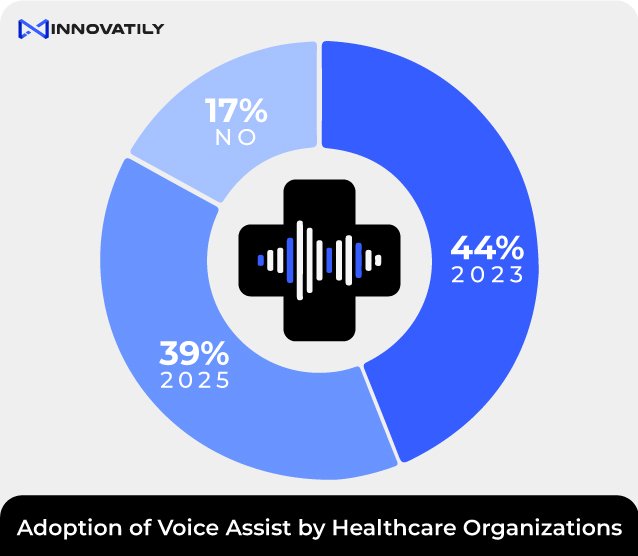The global market size for conversational AI is expected to grow to USD 32.62 billion by 2030. This market growth comes as a result of continued innovation in this space, more so with technology giants like Microsoft, Google, NVIDIA, Meta investing in developing advanced conversational AI solutions. These innovative efforts are bridging the gap between the potential of this technology and its application in businesses. From offloading routine tasks to delivering elevated customer experience, businesses are rapidly adopting conversational AI. Some of the trends outlined below are paving the way for transformative changes in the constantly altering technological landscape.
1. Increased utilization of Hyperautomation in Conversational AI
While conversational AI allows businesses to interact with customers in real-time, integrating hyperautomation tools enables delivering personalized experiences through these conversations. Additionally, hyperautomation of routine tasks can free up resources to invest more time on innovation and creative solutions. Some of the most common use-cases could be customer onboarding across industries which involves elaborate KYC process, customer support for routine queries, automating recruitment process and even infrastructure management.

With hyperautomation, organizations can deliver better customer experiences by automating customer-facing processes, personalizing interactions, resolving queries faster, and providing self-service options. This ability to automate end-to-end workflows enables a seamless, more data-driven personalized experience than ever.
2. Advanced NLP for context-aware conversations

According to a market survey, by the end of 2024, it is estimated that 85% of customer interactions will be managed without a human agent. Today, conversational AI is growing beyond the traditional chatbot implementations and continued efforts in delivering human-like, context aware responses are taking the center stage. Advanced NLP techniques enable Conversational AI systems to comprehend and interpret the nuances, intent, and sentiment in user queries more accurately and can grasp context from ongoing conversations, previous interactions and user history.
The ability to identify human emotions like happiness, frustration, or satisfaction and adopt their responses based on user sentiment enhances user satisfaction and loyalty.
3. Massive increase in voice-based interactions
The advancements in natural language processing (NLP), speech recognition technology, and the increasing adoption of smart devices equipped with voice assistants, has led to a great surge in voice-based interactions. This trend is expected to continue as AI systems become more proficient in understanding and responding to natural language commands and queries. Owing to the convenience and accessibility, voice based conversational AI is seeing a wide-spread adoption across industries, surpassing the traditional interfaces.

In healthcare alone, 44% of organizations are already using voice technology, and an additional 39% plan to adopt it within the next two years. With both patients and physicians believing that voice-based AI solutions can improve workflow and healthcare delivery, voice interfaces are expected to become more prevalent.
With the voice banking market expected to reach $3.7 billion by 2031, the day when customers are able to make banking transactions through voice interactions is not far. Imagine the ease with which customers can make everyday banking operations, without long wait times, not having to repeat multiple verification steps or even submit answers to various IVR bases queries. However, increased financial frauds using AI voice cloning has posed some serious threat to the ease of banking at your fingertips.

These voice cloning techniques use AI to impersonate and extract personal financial information including access to accounts leading to unverified transactions. While this unscrupulous trend is on the rise, the tech community is striving to address these challenges efficiently.
4. Multi-modal multi-channel intelligent conversations

Advancements in multimodal and multi-channel interactions have revolutionized the way users engage with AI systems. While voice continues to dominate the customer engagement, omnichannel engagement is making the stride as 38% of the customers surveyed prefer services and support across multi-channel. Although there are several challenges in seamlessly integrating multiple modalities such as voice, text, images, videos, and gestures, breakthroughs such as OpenAI’s Whisper, an automatic speech recognition (ASR) system, aim to deliver more immersive, intuitive, and personalized experiences.
Conversational AI tools are increasingly leveraging gestures, which is the most natural form of human communication, as the user input to translate them into real-time responses.
On the other hand, the device switching consumer behavior has created a need for brands to work towards delivering a seamless and unified experience across devices and modes. 59% of consumers have used multiple channels to get questions answered. Businesses need to take a closer look at how the device shift influences the channel shift, to ensure a cohesive experience ensuring the context follows the customer across device, channel and mode of the interaction.

5. Focus on industry-specific intelligence
While the larger goal of conversational AI is to streamline operations, enhance customer experiences, and drive business growth, it is imperative to build solutions based on domain-specific knowledge to deliver contextual conversational experiences. The key is to design and deploy AI systems that align with the unique requirements, regulations, and objectives of each industry. Driven by the common need for personalized, efficient, and effective interactions across verticals, technology providers are focusing on deploying NLP models that are trained with industry-specific intent library.
These key trends in conversational AI signify a transformative era in how businesses engage with customers, streamline operations, and drive innovation. Reach us to unlock the potential of conversational AI in 2024 and understand how we can help reshape the future of customer interactions together with advanced conversational AI solutions.

 +1-(737)-373-2593
+1-(737)-373-2593
 +61-(488)-873-815
+61-(488)-873-815

